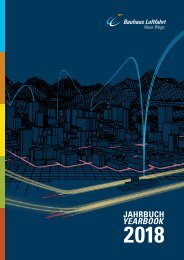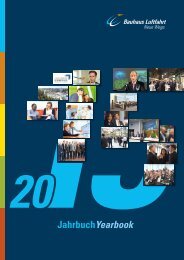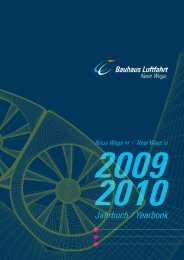Jahrbuch 2008 Yearbook 2008
Sie wollen auch ein ePaper? Erhöhen Sie die Reichweite Ihrer Titel.
YUMPU macht aus Druck-PDFs automatisch weboptimierte ePaper, die Google liebt.
Mit Kohle, Biomasse oder Erdgas fliegen?<br />
Neue Flugkraftstoffe sollten auf jeden Fall eine<br />
hohe Energiedichte besitzen und bei Temperaturen<br />
unter 50 Grad Celsius noch flüssig bleiben.<br />
Das gilt insbesondere für alternative Kraftstoffe,<br />
die als „Drop-in-Fuels“ verwendet werden könnten.<br />
Eine gegenwärtige Option sind die so genannten<br />
Fischer-Tropsch-Kraftstoffe, die sowohl auf der<br />
Vergasung von Kohle oder nachwachsender Biomasse<br />
als auch auf Erdgas basieren. Das jeweilige<br />
Ausgangsmaterial wird in seine Bestandteile zerlegt,<br />
mit Wasserstoff (H 2<br />
) angereichert, so dass ein<br />
Gemisch aus Kohlenmonoxid (CO) und H 2<br />
entsteht.<br />
Mittels Fischer-Tropsch-Synthese wird dieses Gasgemisch<br />
dann in flüssige Kohlenwasserstoffe umgewandelt<br />
(„Coal-to-Liquid“, „Biomass-to-Liquid“,<br />
„Gas-to-Liquid“).<br />
Flying on coal, biomass or natural gas?<br />
New aircraft fuels need to have a high energy density<br />
and remain liquid at temperatures below 50<br />
degrees Celsius. This applies in particular to alternative<br />
fuels which could be used as drop-ins.<br />
One option currently being considered is provided<br />
by Fischer-Tropsch fuels which are based both on<br />
the gasification of coal or renewable biomass and<br />
on natural gas. The feedstock is broken down into<br />
its constituent parts and enriched with hydrogen<br />
(H 2<br />
) to produce a mixture of carbon monoxide (CO)<br />
and H 2<br />
. By means of Fischer-Tropsch synthesis this<br />
gas mixture is then converted into liquid hydrocarbons<br />
(coal-to-liquid, biomass-to-liquid, gas-toliquid).<br />
Angesichts des sinkenden Angebots<br />
an fossilen Kraftstoffen<br />
und der weltweiten Zunahme des<br />
Luftverkehrs braucht die Luftfahrt<br />
eine Alternative zum Kerosin.<br />
Given the decreasing supply of<br />
fossil fuels and the worldwide<br />
increase in air traffic the aviation<br />
industry needs an alternative to<br />
kerosene.<br />
So können Kerosin-ähnliche Kraftstoffe entwickelt<br />
werden. Allerdings kostet ihre Herstellung wiederum<br />
Energie, so dass sorgfältig auf die gesamte<br />
CO 2<br />
-Bilanz geachtet werden muss. Eine andere Alternative<br />
sind Hydrierte Pflanzenöle, die bei der<br />
katalytischen Reaktion von Pflanzenölen mit Wasserstoff<br />
entstehen. Sie weisen viel versprechende<br />
Eigenschaften hinsichtlich ihrer Nutzung in der<br />
Luftfahrt auf.<br />
This makes it possible to develop fuels which are<br />
similar to kerosene. However, producing them will<br />
in itself consume energy, and the overall carbon<br />
footprint will have to be taken into account. Another<br />
alternative is offered by hydrogenated vegetable<br />
oils produced from their catalytic reaction<br />
with hydrogen. They exhibit promising properties<br />
for use in aviation.<br />
// 31














